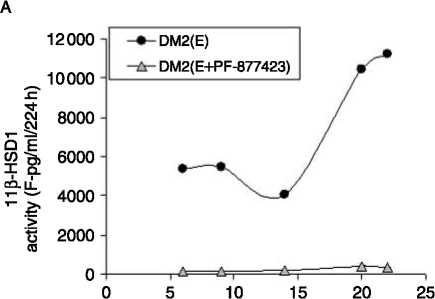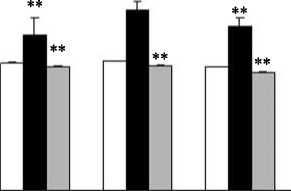11b-HSD1 is essential for human adipogenesis . I J BUJALSKA and others 305

Days of treatment
в
0∙35
3 0∙30
+1
§ 0∙25
Ф
∈ 0-20
ω 0∙15
C
° 0∙10
TJ
⅛ 0∙05
ООО
□ Non-Clifferentiated
■ DM 2(E)
□ DM 2(E+PF-877423)

16 20 22
Days of treatment
Figure 7 (A) Effect of chronic exposure to the selective 11 b-HSD1 inhibitor PF-877423 on subcutaneous s-v cells. 11
b-HSD1 enzyme inhibition by 300 nM PF-877423 measured as the production of cortisol (day 6: 154G8 vs 5387G182;
day 9: 128G1 vs 5489G230; day 14: 174G18 vs 4041G106; day 20: 409G27 vs 10443G78; day 22: 330G7 vs
11218G193 pg/ml per 24 h, meanGS.D., P!0.001, nZ3, EK or ECPF-877423-treated respectively). (B) Inhibition of
lipid accumulation by 300 nM PF-877423 in subcutaneous stromal-vascular cells (day 16: 0.25G0.03 vs 0.20G0.01;
day 20: 0.3G0.02 vs 0.20G0.01; day 22: 0.27G0.01 vs 0.19G0.01; OD (500/660 nm), nZ3, EK or
ECPF-877423-treated respectively), P values: **P!0.01, ***P!0.001.
glucose tolerance through reduced gluconeogenesis and hepatic
glucose output (Kotelevtsev et al. 1997, Morton et al. 2001),
while targeted overexpression of 11b-HSD1 in adipose tissue
recapitulates features of the MS including central adiposity
(Masuzaki et al. 2001). In the liver of db/db mice (a model of
type 2 diabetes), GR and 11b-HSD1 mRNA expression
positively correlated with blood insulin and glucose (Liu et al.
2005). Inhibition of GR and 11b-HSD1 expression either with
GR antagonist (RU486; Liu et al. 2005) orby chronic activation
of liver X receptor (Liu et al. 2006) attenuated the phenotype of
type 2 diabetes in mice.
In humans, the situation is less clear with regard to a role for
11b-HSD1 in the pathogenesis of MS. Some authors have
argued for a primary overexpression of 11b-HSD1 in affected
patients akin to that observed in some animal models
(Paulmyer-Lacroix et al. 2002, Rask et al. 2002). However,
while the expression of 11b-HSD1 might be increased, at least
in subcutaneous adipose tissue in obese patients with MS and
type 2 diabetes (Tomlinson et al. 2002, Alberti et al. 2007), no
such increase was observed in omental adipose tissue.
Furthermore, based on urinary cortisol/cortisone metabolite
ratios and plasma cortisol generation curves following oral
cortisone acetate that primarily reflects hepatic 11b-HSD1
expression, a reduction, not an increase, in 11b-HSD1
expression was observed at least in subjects with simple obesity
(Stewart et al. 1999, Tomlinson et al. 2004). We have argued that
obesity is not primarily a state of 11b-HSD1 overexpression, but
that the fall in hepatic 11b-HSD1 activity with increased visceral
adiposity might serve as a protective mechanism to offset hepatic
glucose output and further adiposity (Valsamakis et al. 2004).
Failure of such a switch off in 11b-HSD1 expression might be a
factor that determines the onset and persistence of hypergly-
caemia in obese patients with type 2 diabetes mellitus
(Valsamakis et al. 2004). Further studies are indicated to define
the exact role of 11b-HSD1 in the pathophysiology of human
MS. Irrespective of the outcome of these studies, selective
inhibitors such as PF-877423 offer a real advance in the
prevention and treatment of diabetes in subjects with obesity
with the potential added benefit of inhibiting adipocyte
differentiation. A reduction in adipogenesis specifically within
omental depots is likely to further improve the metabolic
phenotype of these patients. Clinical studies characterising a
novel, potent (Ki 0.2 nM) and fully selective 11b-HSD1
inhibitor preventing lipogenesis in vitro will further our
understanding of the role of local glucocorticoid metabolism
in human adipose tissue.
Acknowledgements
The work was supported by a Wellcome Trust Programme
Grant (Ref No 066357) and MRC Grant (G0502165). The
authors thank Jeff Zhu for providing the human 11b-HSD1
recombinant protein.
Disclosure
I J B, L L G, J W T and C D declare no conflict of interest. J E,
A N F and P A R are employed by Pfizer. P M S is on the
advisory board for Pfizer Global R&D.
References
Alberti L, Girola A, Gilardini L, Conti A, Cattaldo S, Micheletto G & Invitti
C 2007 Type 2 diabetes and metabolic syndrome are associated with
increased expression of 11b-hydroxysteroid dehydrogenase 1 in obese
subjects. International Journal of Obesity 31 1826—1831.
www.endocrinology-journals.org
Journal of Endocrinology (2008) 197, 297-307
More intriguing information
1. Analyse des verbraucherorientierten Qualitätsurteils mittels assoziativer Verfahren am Beispiel von Schweinefleisch und Kartoffeln2. Financial Market Volatility and Primary Placements
3. The name is absent
4. Cultural Neuroeconomics of Intertemporal Choice
5. Computational Experiments with the Fuzzy Love and Romance
6. Herman Melville and the Problem of Evil
7. The name is absent
8. A NEW PERSPECTIVE ON UNDERINVESTMENT IN AGRICULTURAL R&D
9. DISCUSSION: ASSESSING STRUCTURAL CHANGE IN THE DEMAND FOR FOOD COMMODITIES
10. The name is absent